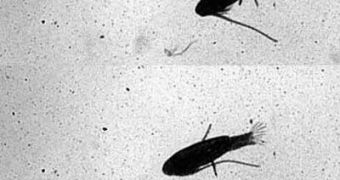Scientists announce the discovery of the fastest known jumper in the animal kingdom. The flea-sized, shrimp-like critter is capable of achieving speeds of up to thousands of times its body length per second, admittedly over very short distances. However, the amount of effort involved in doing so is unrivaled among another species, as soon as body and muscle size and mass is taken into account. The conclusions of the new investigations were drawn after experts watched a series of high-definition videos of three species of the crustaceans copepods, LiveScience reports. These animals proved to surpass any others when it came to the speed of their jumps.
The research team behind the new study also learned that the copepods were perfectly able to reach their top jump speed within milliseconds, which is a record all in itself. The critters can reach a maximum speed of 2 to 4 miles per hour, or about 3 to 6.4 kilometers per hour. For those of you who laugh at these values, know that in human terms this would be equivalent to a fully-grown, 5' 8” individual accelerating to 3,800 miles per hour in less than a second. The acceleration would rip our bodies to pieces, researchers say. The copepod species that was declared champion only grows to an average body size of 1 to 2 millimeters.
“The films we wanted lasted only one second, but they had to be the right one second. Luck and patience were the most important factors in getting the right footage, and whenever we got something exciting on the camera, everybody applauded,” explains Technical University of Denmark marine ecologist Thomas Kiorboe, who was also a researcher on the new investigation. Full details of the work appear in the May 12 online issue of the esteemed scientific Journal of the Royal Society Interface. One of the main highlights in the new paper is the fact that the muscles powering the copepods are capable of producing up to 10 times more force than any other jumping muscles on other species.
“Relative to their size, copepods are stronger than reported for any other animal. And they are also faster, again relative to their size, than any other aquatic animal,” the expert adds. The animal features two sets of propulsion systems, one made up of feeding appendages, which can carry it over long distances, and one evolved exclusively for fleeing. “The escape system is geared for maximum short-term force production, while the swimming system is geared for long-term performance,” Kiorboe says.

 14 DAY TRIAL //
14 DAY TRIAL //